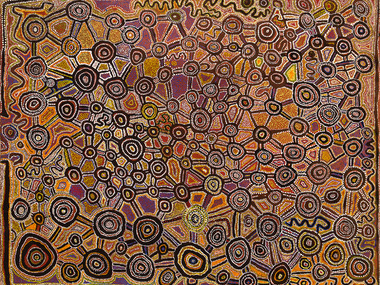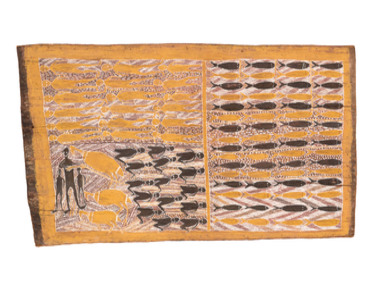ABORIGINAL ART 'COMES HOME'

The 'Artists Unknown' Tingari Dreaming canvas (1989) that's offered in tonight's Mossgreen Aboriginal Art Sale
Posted by Jeremy Eccles | 22.07.14
Dates:
17.07.14
: 23.07.14
Location: 926 High Street, Armadale, Vic 3143
A significant dinner held in Melbourne last week was a homecoming of sorts for that dominant feature of the Aboriginal art market over the past two decades – the auction. Aboriginal art auctions have been maligned, but some have done much to boost prices, to bring early Papunya boards out of the woodwork, to benchmark certain iconic artists, to internationalise the scene and, sadly, to reflect the the fall from grace of the wonderful art of remote Australia as the investors wooed in by rising prices in the early Noughties pulled the plug when the Global Financial Crisis bit.
For the old building that was once the Melbourne home of the pioneering Indigenous art auction house, Sotheby's, is now refurbished and showing off the art that relative newcomer Mossgreen wants you to buy. It also managed to fit in almost 70 diners for the inaugural Annual Australian Indigenous Art Market Dinner, a project by Mossgreen CEO Paul Sumner in an effort to recapture the confidence that accompanied the glory days of the business, as well show off his refurbished home. He'd even done some research to discover that the original architect of the former Armadale Picture Theatre was called Klingender, a name richly associated today with both the auction business and Sotheby's tenure of the building.
Also being underlined at the event was the recent move by Indigenous art specialist D'Lan Davidson from Sotheby's Australia to Mossgreen – leaving the founding fathers without an expert in this area, and presumably ceasing to hold specialist auctions.
Davidson told me that the event was intended to bring the industry together, with invitations sent widely to specialists and dealers in Aboriginal art. But as far as I could see the separatism that haunts the business meant that only a single Melbourne dealer attended – Willie Mora – and one or two visitors were noted from Brisbane and Adelaide. But Sydney didn't think it was worth the price of an air ticket. In fact, 85% or so of attendees were clients of Mossgreen – which no doubt made the promotional cost worth the effort, but endangers the event's warmly embracing title.
Speakers included those inveterate catalogue essayists, Wally Caruana and John Kean – with the former pointing out that the art which surrounded us was by any standards an exhibition of quality and variety that public institutions “rarely offer” these days. Perhaps he was thinking of his own time as the first Indigenous curator at the National Gallery?
John Kean, who's life around Aboriginal art has traversed the early days of Papunya Tula, the founding of Tandanya and the Melbourne Museum, began by introducing his audience to the presence of another pioneer, Janet Wilson/Holt who had inducted him into the skills of running Papunya Tula back in the 1970s by making him catalogue and draw 500 unsold and unlisted works of art in a back room, which had taught him everything he needed to know about how they worked as art.
Kean also reminisced about many of the artists he'd known whose works were shown in the room....Uta Uta Jangala, Charlie (Tarawa) Watuma (“If he was in this room, I wouldn't be standing and speaking!”), Ronnie Tjampitjinpa and Turkey Tolson. “But it was Kaapa (Tjampitjinpa) who invented Aboriginal art, taking it from an anthropological past to its gallery present. He began by imitating Namatjira (and there was one of Kaapa's early water-colours on display), and then stole art materials from the Papunya school in order to make his own style of art, which he sold door to door. The December 1971 work for sale ('Wild Orange Dreaming') is a clear exercise in symmetry – going beyond the representation of events, and using the graphic potential of paint to express their poetry. His genius was to recognise that while still deriving their imagery from ceremony, his compositions could satisfy as discreet, portable artworks”.
John Kean then drew his audience's atention to an unstretched canvas lying out of sight and flat. 'Western Desert Men's Collaboration' (1989) is the best the catalogue can be certain about, with the subject matter of 'Tingari Dreaming'. It's a magnificent mosaic of dots, circles and lines in mellow hues that appears to have had its origins during ceremonies at Wiluna in WA. Although sold by a 'taller man' (who may have been John Malpantji (or 'Tarzan') Ward, who was a major Tingari custodian around Wiluna), it's hypothesised that late, great names such as Jacky Giles and Fred Ward were part of the team that created this during the white heat of ceremony.
In Kean's speech, he amplified this process: “The elders would start such a work with appropriate song, and then the detailed dotting would be added by younger men as part of their initiation into the communality of the Wati Language mysteries that spread right across the Western Desert”.
Definitely a museum piece – if any of them have the money!
Others - in my view - in that class for sale this evening (from 6.30pm) and tomorrow afternoon, include a pair of sculptures of Purukapali and his wife, Bima by the innovative Cardo Kerinauia from Paru on the Tiwi Islands in 1959 and a sensational carved and painted buffalo by his colleague Albert Croker; a Wandjuk Marika bark telling a small part of the clan's mighty Djan'kawu Sisters creation story – also 1959; exceptional works by Tommy Watson, Lilly Kelly and Bill Whiskey; a richly representative collection of early Balgo works; and a fascinating reproduction of the Gurirr Gurirr boards that Rover Thomas made so famous by Tiger Moore, who inherited this Dreaming when Rover died. They were made on framed fly-screens in 2003, thus reproducing something of the 'found' nature of art from the early days of the movement. A tiny Charlie Numbulmoore bark Wandjina is the pick of a large number on offer in the sale.
Will the auctioneers' optimism about a return to confidence by the market be reflected in prices tonight? Many people must hope so.
URL: http://www.mossgreen.com.au
Share this:
»  del.icio.us
»
del.icio.us
»  Digg it
»
Digg it
»  reddit
»
reddit
»  Google
»
Google
»  StumbleUpon
»
StumbleUpon
»  Technorati
»
Technorati
»  Facebook
Facebook
Contact Details

The gorgeous scultping of a buffalo by Tiwi/Iwadja man, Albert Croker from 1959

The Wandjuk Marika bark, 'Djan'kawu at Yalan'bara' from 1959 offering an allegory of life from birth to death.
Further Research
Artists: Albert Croker | Albert Namatjira | Bill Whiskey | Cardo Kerinauia | Charlie (Tarawa) Watuma | Charlie Numbulmoore | Fred Ward | Jacky Giles | Kaapa Tjampitjinpa | Lilly Kelly | Ronnie Tjampitjinpa | Rover Thomas,Tiger Moore | Tommy Watson | Turkey Tolson | Uta Uta Jangala | Wandjuk Marika
News Tags: Aboriginal art auctions | Jeremy Eccles | John Kean | Mossgreen | Paul Sumner | Sotheby's | Wally Caruana
News Categories: Auction | Australia | Blog | Event | Exhibition | Feature | Industry | News
Exhibition Archive
- 10.10.17 | TARNANTHI 2017
- 11.08.17 | Natsiaas 2017
- 20.07.17 | APY ART DOMINATES THE WYNNE
- 17.07.17 | Anangu Artist Wins $100,000 Prize
- 14.07.17 | The End of AAMU
- 11.07.17 | ART ACROSS THE COUNTRY
- 11.07.17 | TARNANTHI IN OCTOBER
- 05.07.17 | TJUNGUṈUTJA - from having come together
- 13.06.17 | Ghost-Nets Straddle the World
- 07.06.17 | Grayson Perry Going Indigenous?
- 05.06.17 | Barks Bigger than Ben Hur
- 27.05.17 | NGA QUINQUENNIAL 2017
- 21.05.17 | Blak Douglas Finds Home at the NGA
- 21.05.17 | BRIAN ROBINSON WINS HAZELHURST WOP
- 18.05.17 | PARRTJIMA 2.0
Advertising

